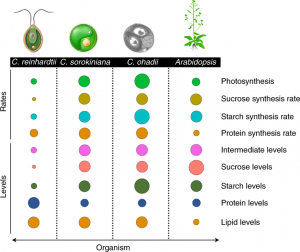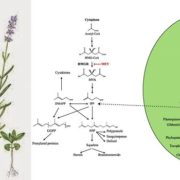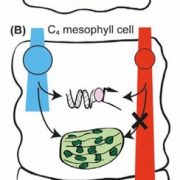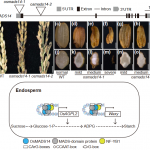Carbon flux through photosynthesis and central carbon metabolism show distinct patterns between algae, C3, and C4 plants (Nature Plants)
 Photosynthesis is an attractive target for improving crop yields, and tailoring downstream photosynthesis-associated metabolism is a relatively unexplored path for achieving this. Chlorella ohadii is the fastest growing photosynthetic organism identified, has high photosynthetic rates, and can survive extreme illumination levels. Here, Treves et al. show how higher metabolic flux in C. ohadii could explain this fast growth compared to two other algae, Chlamydomonas reinhardtii and Chlorella sorokiniana, as well as differences in C.ohadii grown in low versus high light. They also demonstrate that all three algae display increased fluxes compared to the plants Arabidopsis (C3) and maize (C4). The authors used a microfluidics system for rapid pulse-chase 13CO2 labelling experiments and measured labelling kinetics over both short (5 – 40 s) and longer (15 – 300 min) time scales. The first measured 20 metabolic intermediates of the Calvin Benson Cycle, and the second measured flux into downstream sugars, intermediates of the tricarboxylic acid cycle and amino acids. K-means clustering on the enrichment kinetics in these experiments explored trends in metabolic fluxes grouped into four clusters for both experiments. Rates of protein and lipid synthesis were also highest in the Chlorella species. The higher anaplerotic flux (the flow of fixed carbon directed towards replacing TCA cycle intermediates) in algae compared to plants could support the increased carbon supply needed for the higher rate of protein synthesis and growth. (Summary by @Jiaaawen) Nature Plants 10.1038/s41477-021-01042-5
Photosynthesis is an attractive target for improving crop yields, and tailoring downstream photosynthesis-associated metabolism is a relatively unexplored path for achieving this. Chlorella ohadii is the fastest growing photosynthetic organism identified, has high photosynthetic rates, and can survive extreme illumination levels. Here, Treves et al. show how higher metabolic flux in C. ohadii could explain this fast growth compared to two other algae, Chlamydomonas reinhardtii and Chlorella sorokiniana, as well as differences in C.ohadii grown in low versus high light. They also demonstrate that all three algae display increased fluxes compared to the plants Arabidopsis (C3) and maize (C4). The authors used a microfluidics system for rapid pulse-chase 13CO2 labelling experiments and measured labelling kinetics over both short (5 – 40 s) and longer (15 – 300 min) time scales. The first measured 20 metabolic intermediates of the Calvin Benson Cycle, and the second measured flux into downstream sugars, intermediates of the tricarboxylic acid cycle and amino acids. K-means clustering on the enrichment kinetics in these experiments explored trends in metabolic fluxes grouped into four clusters for both experiments. Rates of protein and lipid synthesis were also highest in the Chlorella species. The higher anaplerotic flux (the flow of fixed carbon directed towards replacing TCA cycle intermediates) in algae compared to plants could support the increased carbon supply needed for the higher rate of protein synthesis and growth. (Summary by @Jiaaawen) Nature Plants 10.1038/s41477-021-01042-5









